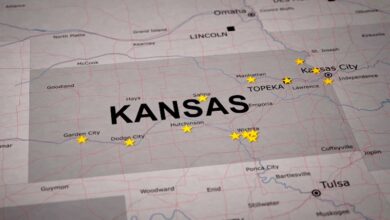Local historic mansions offer Christmas tours

Kansas Citians looking for some last-minute decorating ideas can find inspiration at one of the area’s many historic homes that are open for holiday tours. Here are some suggestions from KCUR.
Bingham-Waggoner Mansion & Estate, Independence. Every room of the home is decorated, and the house has more than 50 Christmas trees. A version of the Bingham-Waggoner Mansion & Estate has been on this land since roughly 1827, with the original home built in 1856 and restored in 1890.
The residence is categorized as a Victorian, which simply means it was built during the reign of Queen Victoria (1830-1910). This was the home of artist George Caleb Bingham and where he painted “Order #11” as an act of defiance to the Union Army’s command that all residents be removed from Jackson, Cass, Bates and northern Vernon counties in 1863.
For the last 50 years, the Bingham-Waggoner estate has brought holiday cheer to the metro. Every room of the mansion is decorated, from the butler’s pantry and servants’ quarters to the hand-carved staircase and main dining room. On guided tours, visitors will find an exquisite display of Christmas trees, white ribbons and lights cascading through the branches like shooting stars. Period decorations from the 1860s and 1870s adorn tabletops. The staircase is wrapped in garland, pearls, ribbon, and ornaments.
Alexander Majors House, Kansas City. Alexander Majors is known primarily for the creation of the Pony Express, where riders would deliver mail from St. Joseph all the way to California. In 1856, he built his estate in Kansas City, characterized by four large white columns and a second-story balcony where he could overlook a 300-acre farm and manage his shipping company. The home is built in the Greek Revival style as a symbol of his wealth and power.
John Wornall House, Kansas City. Built in 1958 by John B. Wornall, this home is another example of the Greek Revival style of architecture with red brick, symmetrical window, and four large white columns that frame the entryway. His father, Richard Wornall, brought the family from Kentucky when John was 21,and purchased 500 acres that now cover the area from 59th to 67th Streets and Main to State Line.
Sitting on the road now that bears the family name, the home was used as a field hospital by both Union and Confederate soldiers during the Battle of Westport, sometimes referred to as the Gettysburg of the West. Wornall himself was not present at the battle, having fled after the Union’s Order #11, which commanded Missouri residents across the region to evacuate.
The Wornall Estate remained in the family until 1962 and was later sold to the Jackson County Historical Society, which decorates the home for the holidays, with garland filling the mantles.
Vaile Mansion, Independence. It takes volunteers an entire month to decorate the home. Built in 1881 by Harvey Vaile and his wife Sofia, and modeled after a building in Normandy, France, it’s designed to bring some European culture to the Midwest. A perfect example of the Second Empire style of Victorian architecture, its distinguishing tower rises above the center. Dormer windows, which have little peaks as their own structure, are a definitive feature of this style.
The mansion features 31 rooms, nine marble fireplaces, painted ceilings, a 6,000-gallon water tank and a wine cellar capable of holding up to 48,000 gallons. After the Vailes’ deaths — Sofia in 1883 and Harvey in 1895 — the mansion has had an interesting history. It’s has served as a nursing home, sanitorium, the center of operations for a water bottling company and finally, since 1983, a museum run by the Vaile Victorian Society.
For the holiday season, you get a full European Victorian Christmas that begins with decorated garland wrapped around the porch rails and leads to double doors with mounted wreaths. Once inside, white crystal chandeliers (two of which were meant for the White House) bathe the inside with clear light, as if it’s reflected off snow.
Corinthian Hall at Kansas City Museum, Kansas City. Corinthian Hall is the centerpiece of the estate of lumber baron R.A. Long. The grounds contain numerous outbuildings under renovation or construction, such as the carriage house, the future Jewel House, which reimagines the original conservatory on the property, and the future James Turrell’s Skyspace, a chamber with an opening in the ceiling so visitors can gaze at the sky.
READ: Kansas City Christmases past
Corinthian Hall finished construction in 1910 in the Beaux-Arts style of architecture, which is characterized by stone construction, large columns and a “hierarchy of interior spaces.” The 70-room, 35,000-square-foot mansion now houses the Kansas City Museum. After years of effort, Corinthian Hall has been fully restored and ready to make holiday dreams come true with beautiful decorations.
The Kansas City Museum has partnered with Kansas City’s own Nell Hills interior designers to decorate this year. Last year featured a 10-foot-tall blue spruce in the grand hall. The color palette, according to Nell Hills, is “glittering gold, frosted white and touches of deep red to add depth to the design.”
Cruise-Scroggs Mansion, Kansas City, Kan. Built in the Queen Anne style of Victorian homes, the Cruise-Scroggs Mansion is home to the Strawberry Hill Museum. Run by the Strawberry Hill Ethnic Cultural Society, it celebrates the city’s diverse backgrounds.
Constructed in 1887 by John and Margaret Scroggs, the mansion has a second-floor balcony, decorative lattice and at one time had stained and leaded glass windows. John Scroggs, a lawyer, was a pioneer of the Wyandotte County Bar Association. The home served as a statement of his success and was built at the time on a place called Splitlog’s Hill.
For the holidays, the home is decorated with extensive garland, lights and Christmas trees. If offers nighttime tours so that guests can see the home in a way that accentuates the decorations.
–Anita Widaman | MV







